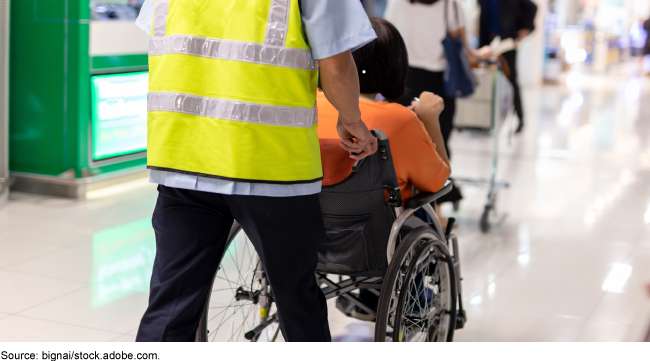Passengers with Disabilities: Airport Accessibility Barriers and Practices and DOT's Oversight of Airlines' Disability-Related Training
Fast Facts
Air travel for people with disabilities can be very challenging if airport facilities aren't accessible and reasonable accommodations aren't provided.
Passengers with disabilities face infrastructure, information, and customer service barriers at U.S. airports. For example, complex terminal layouts and long distances between gates can be hard to navigate. Additionally, travel information isn't always available in a format that is accessible to all.
To improve access for people with disabilities, airports can employ practices like consulting with external disability community and passenger groups to identify barriers and develop solutions.

Highlights
What GAO Found
Passengers with disabilities face infrastructure, information, and customer service barriers at U.S. airports, according to representatives of selected airports, disability advocacy organizations, as well as a review of relevant literature.
- Infrastructure barriers can include complex terminal layouts and long distances between gates and can be difficult for some to navigate.
- Essential travel information is not always available in a format accessible to all. For example, a person with hearing loss could miss crucial gate information that is solely provided over a loudspeaker.
- A passenger might not receive appropriately sensitive service, such as wheelchair assistance, at the airport, although the service provided is required by the Air Carrier Access Act of 1986 (ACAA) regulations.
According to stakeholders, while no solution meets all needs, a number of practices can help reduce or eliminate some of these barriers to equal access at airports. For example, some selected airports use external disability community and passenger groups to proactively engage in identifying barriers and develop solutions. Other airports have implemented technology-based solutions, such as mobile phone applications to make airport navigation easier.
Examples of Stakeholder-Identified Features to Assist Airport Passengers with Disabilities

The Office of Aviation Consumer Protection within the Department of Transportation (DOT) is responsible for oversight of airlines' compliance with the ACAA. In 2008, DOT updated its entire ACAA regulation, including adding new training requirements for airline personnel, such as requiring training to be recurrent. Following this update, DOT conducted outreach to domestic and foreign airlines on the changes and reviewed airlines' disability training sessions and materials. Agency officials said that in recent years, DOT has conducted reviews of airlines' training only when passengers' complaints indicate a possible problem, as officials' analyses have not shown training generally to be a significant cause of service violations. DOT officials and stakeholders said other factors, such as limited availability of staff to assist passengers with disabilities, at times may affect the service passengers with disabilities receive. DOT is assessing some of these factors through the statutorily mandated ACAA Advisory Committee, formed in late 2019 to make recommendations to improve accessibility to air travel. The committee met in 2020, established three subcommittees, and plans to reconvene by summer 2021.
Why GAO Did This Study
Approximately 43 million people in the United States have some type of disability, which may affect mobility, vision, hearing, and cognition. Without accessible airport facilities and accommodations—such as appropriate assistance from the check-in counter to the gate, or effective communication of flight information—air travel for people with disabilities can be extremely challenging.
The FAA Reauthorization Act of 2018 includes provisions for GAO to review leading airport accessibility practices for passengers with disabilities, as well as required training for airline and contract service personnel who assist these passengers within the airport. This report examines, among other objectives: stakeholder-identified barriers that passengers with disabilities face when accessing airport facilities, accessibility practices to assist passengers with disabilities, as well as how DOT has overseen airlines' disability-related training.
GAO reviewed relevant federal laws, regulations, DOT documents, literature, as well as information describing disability training provided by selected airlines and contractors. GAO interviewed a non-generalizable sample of stakeholders, including those at 16 U.S. airports selected based on size and geography, eight large and low-cost domestic airlines selected based on the greatest number of disability-related passenger complaints and enplanements, and six aviation service contractors working for those airlines. GAO also conducted interviews with DOT officials and 10 disability advocacy organizations, among others.
For more information, contact Heather Krause at (202) 512-2834 or krauseh@gao.gov.
